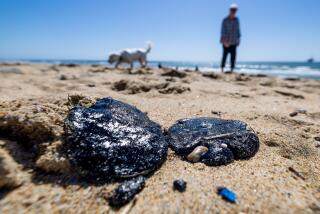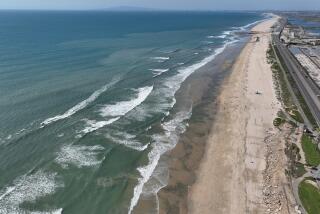Efforts Focus on Murky Cleanup
- Share via
SEATTLE — With dimming hopes of finding six crewmen missing in frigid Alaskan waters, the U.S. Coast Guard on Friday shifted its focus to containing a spreading slick of fuel oil from a broken cargo ship which officials feared could become the worst oil spill in Alaskan waters since the 1989 Exxon Valdez disaster.
A growing assemblage of cleanup workers managed to lay down a few plastic curtains to block oil from contaminating prized salmon streams and other sensitive habitat for endangered birds and marine mammals along the northwest shore of Unalaska Island in the middle of the Aleutian archipelago.
But cleanup and search efforts were thwarted by fierce winds and rough seas around the island, about 800 miles southwest of Anchorage.
The remote, rocky coastline where the two pieces of the ship remain adrift is accessible only by sea or by air. This time of year, rescue and cleanup crews have five hours of daylight in which to operate.
It’s a “worst-case scenario,” said Lynda Giguere of Alaska’s Department of Environmental Conservation. “Worst for location. Worst for weather. And worst case as far as the potential for oil spilled.”
The 738-foot Malaysian ship, Selendang Ayu, was en route to China from Seattle with a load of soybeans Tuesday, when its engines lost power and it went adrift. The crew attempted repairs and to set anchor, but the next day lost the ship on the rocks. The vessel split into two nearly equal pieces.
While airlifting the crew Wednesday night, a Coast Guard rescue helicopter crashed into the sea. A second helicopter was able to rescue the Coast Guard crew and all but six members of the cargo ship’s crew. Five of the missing crewmen were citizens of India, and one was from the Philippines.
“We are still continuing the search,” said Coast Guard Petty Officer Cindy Marshall. “There are some rumors going around that bodies have been seen in the water, but we have not seen anything like that.”
Forrest Bowers, who oversees the Aleutian Islands for Alaska’s Department of Fish and Game, flew over the wreckage with salvage workers in a helicopter Thursday. He said he spotted at least one otter and a few seabirds in the slick. “The birds were right in the oil.”
No flights for cleanup and wildlife workers made it out on Friday because of high winds and blowing snow. That left officials guessing about the extent of the spill and damage to the environment. The ship was carrying nearly half a million gallons of viscous bunker oil and diesel fuel, but no one was certain how much had been released into the water.
By comparison, the Exxon Valdez, an oil tanker carrying crude oil disgorged 11 million gallons into Prince William Sound, killing thousands of birds and devastating other marine life. The lingering toxic effect of oil continues to kill pink salmon eggs, suppress populations of sea otters, harlequin ducks and other wildlife more than 15 years later, scientists say.
The Malaysian freighter spilled its oil in the Alaska Maritime National Wildlife Refuge, a biologically sensitive area that encompasses a large swath of the Aleutians including the capes and bays around the shipwreck.
State and federal wildlife officials are most concerned about oiled birds and sea otters, which rely on feathers or fur for insulation in the cold.
Unalaska is rich in sea birds, including two types of endangered sea ducks -- the spectacled and Steller’s eiders -- and emperor geese, bald eagles, loons, murrelets, mergansers, and goldeneye and harlequin ducks.
Bruce Woods of the U.S. Fish and Wildlife Service in Anchorage said it was fortunate that the spill didn’t occur in the summer when large flocks of horned puffins and glaucous-winged gulls migrate to Skan Bay for nesting.
He and other officials are concerned about another blow to sea otter populations in the Aleutians, which have plunged sharply in the last few decades from about 100,000 to about 3,300. Scientists have long worried about an oil spill wiping out the survivors.
Jim Estes, a federal biologist who has studied Aleutian otters for some 30 years, said the spill occurred in a particularly vulnerable place. “It’s in an area that is already in crisis as far as coastal wildlife,” he said. He estimated that as many as 400 otters lived in the waters around Unalaska Island.
Brad Smith, a biologist with National Marine Fisheries Service in Anchorage, said the oil spill had reached two places where endangered Steller sea lions beached themselves in Skan Bay. He said he had received reports of 27 Steller sea lions near the spill.
“Stellers are not as sensitive because they have blubber for warmth and don’t rely on fur,” he said. Still, the toxic effect of oil, including poisonous vapors and residues, can take a toll, especially on young Stellers and harbor seals.
He said he was alarmed to learn that the same winds that were impeding cleanup efforts appeared to be blowing the oil slick toward Makushin Bay, an area with abundant wildlife, which is used as fishing grounds for tanner crabs, herring, salmon and halibut.
Greg Hawthorne, who runs a recreational fishing camp about 10 miles from the spill, said humans, too, would pay a price for wildlife losses. “It is us, the Aleutian Islanders, who are going to suffer for this,” he said.
“We are talking about one of the most pristine, most beautiful areas in the world. I mean you can literally stand in an area that hasn’t had human footprints for a thousand years. It is truly one of the few wild places that hasn’t been spoiled by man.”
Cleanup crews boarded a vessel which is expected to arrive at the wreckage this morning and begin corralling the oil and skimming it from the ocean’s surface. Several commercial fishing boats will join the effort.
“It’s going to be a hard job,” Hawthorne said. “But it happened, and we have to fix it and make sure it is done right.”
Marshall reported from Seattle, Weiss from Los Angeles. Times staff writer Marla Cone in Los Angeles contributed.
More to Read
Sign up for Essential California
The most important California stories and recommendations in your inbox every morning.
You may occasionally receive promotional content from the Los Angeles Times.










